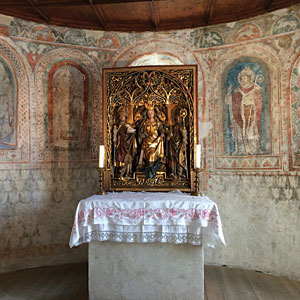Using the term “faux finish” in Google will produce more than four million results. When we in the wall and ceiling industry think faux, it conjures up a host of new terms, words and meanings. We could go as far to say it is a whole new vocabulary, unique to our industry—maybe a “fauxcabulary”? This is testament to the growing popularity and desire by owners for more upscale finishes.
Plaster is certainly not new, neither is polished plaster or faux finishes. Plaster has been traced back to several thousands of years before the birth of Christ. Few products in construction can proclaim such a long and rich history. Today, the new term faux finish is popular among the public and disdained by some plaster traditionalists. Some faux finishes can be linked to a variety of paint-based products. Others require skilled craftsman to emulate the look of the “old-style” products and should not be applied by ambitious do-it-yourselfers. When applied right, a lot of these faux finishes certainly have their place in construction that recall the real polished or Venetian plasters made from natural limes.
For those of us lucky enough to travel Europe, there is no shortage of historic plaster to observe. I recently got back from northern Italy. The use of polished plaster, Marmarino or Stucato is widespread and wonderful to see. Even in more low-key rooms, such as the men’s room at Hanger 7 in Salzburg, Austria, was finished with a deep blue polished plaster. (My European family is constantly amazed at me: “Taking pictures in the bathroom at Hanger 7, are you crazy?”)
The Old Plaster
The real treat is the old plaster, the Fresco’s that can be found in Italy are worth the trip alone. Tirol castle is open to public for tours for a modest fee. The origins of the castle can be traced back to before 1100. It is big, impressive and well preserved. The wood beams are massive as they span rooms that have hosted everything from parties to war preparations. For the plaster enthusiast, the chapel was built in the 1300s and the frescos are well preserved for us to still admire. The term fresco is used to describe the technique of mural paintings on freshly laid lime plaster. This allows the paint to be integral with the wall, and thus last for centuries. I stood in amazement and wondered if the plasterers knew they would last 700 years.
One room had an archive of drawings, these were blue prints of the day. The drawings were amazing and beautiful. My brother-in-law found a detail for one of the castle’s windows. I can tell you it bared no resemblance to the window details of today’s buildings. I suspect the architect relied on the skill of the craftsman, providing only basic information and letting the installer work out the details. Maybe things have not changed that much?
So as not to be lost in the moment of just construction history, the room next to the chapel had a museum of unique artifacts specific to the period of about 1500. I looked at a small item in the glass case that held two fake thumbs inside. It was an authentic thumb screw device designed for torture. Of course what good would this be without a full manual for instructions? The description was a complete guide manual on how to exact as much pain as possible to achieve submission or a confession.
If you get the chance to visit Europe, please do so. If you get local tour guides, it is even better. They know which castles, and there are a lot of them, to visit. For example, from my wife’s family home, they have a view of three such castles in the distance. Some are in ruins, yet some are in good condition and the plaster work is amazing. If you’re like me, you could spend all day at those castles.





Report Abusive Comment